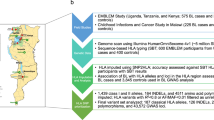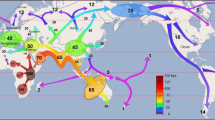Abstract
Epidemiological studies suggest that childhood common acute lymphoblastic leukaemia (c-ALL) may be the rare outcome of early post-natal infection with a common infectious agent. One of the factors that may determine whether a child succumbs to c-ALL is how it responds to the candidate infection. Since immune responses to infection are under the partial control of (human leucocyte antigen) HLA genes, an association between an HLA allele and c-ALL could provide support for an infectious aetiology. To define the limit of c-ALL susceptibility within the HLA region, we have compared HLA-DQB1 allele frequencies in a cohort of 62 children with c-ALL with 76 newborn controls, using group-specific polymerase chain reaction (PCR) amplification, and single-strand conformation polymorphism (SSCP) analysis. We find that a significant excess of children with c-ALL type for DQB1*05 [relative risk (RR): 2.54, uncorrected P=0.038], and a marginal excess with DQB1*0501 (RR: 2.18; P=0.095). Only 3 of the 62 children with c-ALL have the other susceptibility allele, DPB1*0201 as well as DQB1*0501, whereas 15 had one or the other allele. This suggests that HLA-associated susceptibility may be determined independently by at least two loci, and is not due to linkage disequilibrium. The combined relative risk of the two groups of children with DPB1*0201 and/or DQB1*0501 is 2.76 (P=0.0076). Analysis of amino acids encoded by exon 2 of DQB1 reveal additional complexity, with significant (P<0.05) or borderline-significant increases in Gly26, His30, Val57, Glu66-Val67 encoding motifs in c-ALL compared with controls. Since these amino acids are not restricted to DQB1*0501, our results suggest that, as with DPB1, the increased risk of c-ALL associated with DQB1 is determined by specific amino acid encoding motifs rather than by an individual allele. These results also suggest that HLA-associated susceptibility to c-ALL may not be restricted to the region bounded by DPB1 and DQB1.
This is a preview of subscription content, access via your institution
Access options
Subscribe to this journal
Receive 24 print issues and online access
$259.00 per year
only $10.79 per issue
Buy this article
- Purchase on Springer Link
- Instant access to full article PDF
Prices may be subject to local taxes which are calculated during checkout
Similar content being viewed by others
Author information
Authors and Affiliations
Rights and permissions
About this article
Cite this article
Dearden, S., Taylor, G., Gokhale, D. et al. Molecular analysis of HLA-DQB1 alleles in childhood common acute lymphoblastic leukaemia. Br J Cancer 73, 603–609 (1996). https://doi.org/10.1038/bjc.1996.104
Issue Date:
DOI: https://doi.org/10.1038/bjc.1996.104
This article is cited by
-
Association between HLA-DQB1 gene and patients with acute lymphoblastic leukemia (ALL)
International Journal of Hematology (2012)
-
Epidemiology and genetics of childhood cancer
Oncogene (2004)



